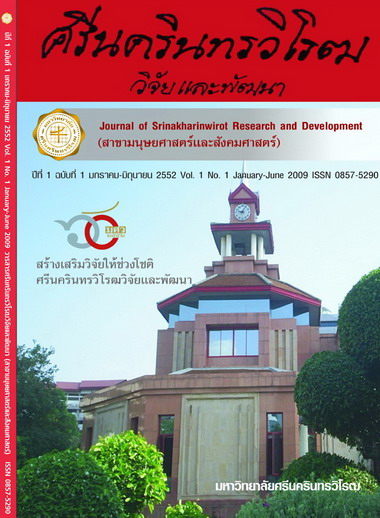รูปแบบที่เหมาะสมสำหรับการจัดการหมู่บ้าน เพื่อพัฒนาคุณภาพชีวิตของประชาชนแบบพอเพียงในหมู่บ้าน จังหวัดสุรินทร์ ประเทศไทย (Appropriate Management Model for the Sufficiency Quality of Life Development in the Village of Surin Province Thailand)
คำสำคัญ:
an appropriate model, village’s management, a life quality development and a philosophy of Sufficient Economy.บทคัดย่อ
บทคัดย่องานวิจัยนี้มีจุดมุ่งหมายเพื่อศึกษาบริบทชุมชนและปัจจัยที่ส่งผลต่อการพัฒนาคุณภาพชีวิตของประชาชนแบบพอเพียง เพื่อหากรอบ เกณฑ์ ตัวชี้วัด เพื่อหารูปแบบ เนื้อหา กระบวนการที่เหมาะสมสำหรับการจัดการหมู่บ้านเพื่อพัฒนาคุณภาพชีวิตของประชาชนแบบพอเพียง ของชุมชนคาบเหนือ ตำบลเทนมีย์ อำเภอเมือง จังหวัดสุรินทร์ ใช้เทคนิคการวิจัยเชิงคุณภาพ โดยวิธีการสังเกต สัมภาษณ์แบบเจาะลึก การประชุมกลุ่มย่อย ใช้เทคนิค AIC เทคนิค SWOT และกระบวนการวิจัย PR&D ที่คนในชุมชนมีส่วนร่วมเป็นผู้วิจัย เน้นการพึ่งตนเองตามแนวทางปรัชญาเศรษฐกิจพอเพียง ดำเนินการวิจัยโดยใช้กระบวนการค้นหาระบบคุณค่าจากภูมิปัญญาดั้งเดิมมาบูรณาการ เชื่อมโยงสานต่อกันบนฐานการเรียนรู้ การวางแผน การดำเนินการของชุมชน และใช้พลังทางสังคมขับเคลื่อนกระบวนการพัฒนาในรูปของเครือข่าย นำมาประยุกต์เป็นฐานใหม่ตามบริบทวัฒนธรรมและสิ่งแวดล้อมในท้องถิ่น ที่ชุมชนร่วมกันคิดค้นการแก้ปัญหาอย่างมีส่วนร่วม เพื่อให้เกิดการรวมกลุ่มพัฒนาคุณภาพชีวิตในด้านต่างๆ ตามความถนัด สร้างผลผลิต สร้างรายได้ และพัฒนาให้ชุมชนคาบเหนือพึ่งพาตนเองได้ ผลการวิจัยพบว่า ชุมชนนี้เคยเป็นเส้นทางผ่านของคนเขมรที่บรรทุกปลาย่างมาขายและซื้อเครื่องบริโภคอุปโภคกลับลงไป มีทุนทางทรัพยากร เช่น ห้วยอำปึล ห้วยระหาร เป็นแหล่งน้ำที่เกิดจากเทือกเขาดงรักที่ชุมชนใช้ประโยชน์ด้านเกษตรกรรม มีอัตลักษณ์ด้านวัฒนธรรมที่ยึดมั่นในพุทธศาสนา และความเชื่อแบบเขมรดั้งเดิม การศึกษาเพื่อหากรอบ เกณฑ์ ตัวชี้วัด และการขับเคลื่อนแผนสู่การปฏิบัติของชุมชนคาบเหนือ ได้กรอบ คือ "ชุมชนมีคุณภาพชีวิตที่ดี อยู่ดีมีสุข ไม่เป็นหนี้สิน ชุมชนเข้มแข็ง" ได้เกณฑ์ 5 ด้าน คือ "ด้านสังคมวัฒนธรรม เศรษฐกิจ การศึกษา สิ่งแวดล้อมและสุขภาวะ และด้านการปกครอง" มีตัวชี้วัดรวม 25 ตัว มีโครงการรวม 40 โครงการ โครงการที่ประสบความสำเร็จในการขับเคลื่อนแผนชุมชนสู่การปฏิบัติจำนวน 4 โครงการ คือ โครงการอาบน้ำผู้สูงอายุ โครงการออมทรัพย์ โครงการปุ๋ยอินทรีย์ และโครงการถ่ายทอดภูมิปัญญา ผลการหารูปแบบ เนื้อหา กระบวนการที่เหมาะสมสำหรับการจัดการหมู่บ้านเพื่อพัฒนาคุณภาพชีวิตของชุมชนคาบเหนือแบบพอเพียง จะต้องเน้นที่ 1) กระบวนการเรียนรู้และการจัดการชีวิต จัดการทรัพยากร จัดระบบเศรษฐกิจสังคมของชุมชน 2) สถานที่ที่คนในชุมชนไปพบปะ ประชุม แลกเปลี่ยนเรียนรู้ และทำงานร่วมกัน 3) คณะกรรมการ ซึ่งเป็นผู้แทนจากคนในชุมชนมาร่วมกันพัฒนา 4) ยุทธศาสตร์ใช้การประชาพิจัยทำแผนแม่บทชุมชน 5) เนื้อหา ของกระบวนการเรียนรู้ และการจัดการขึ้นอยู่กับบริบทขของชุมชนนั้นๆ
Abstract
This research aimed at studying community contexts of the people’s life Quality in order to search for a model, criteria, indexes, patterns, contexts and procedures appropriate for the management. Appling a qualitative research technique by observation, in-depth interview, focus group, AIC, SWOT, and PR&D The procedures which emphasize the people’s participation, the study was conducted at Karpnuer community, Tenmee sub-district, Muang district of Surin province.
The research applied searching procedures for value systems from local wisdom to integrate and transfer, which based unitedly on the people’s learning, planning and proceeding. A social power was used in the development procedures of networks and an attempt applied resulted into a new base according to local cultural and environmental contexts where the people united participatively in thinking and solving problems. This formed the people’s gathering into groups for life quality development in various aspects according to their skills, which yielded products, income and helped in the development of the people at Karpnuer community to be able to depend on themselves. The research findings and conclusions revealed that:
Karpnuer community used to be a traveling route of Khmer people who carried dried roasted fish for selling and buying goods for their utilization and consumption on the way back Natural resources viewing as capital include Ampel and Huay Raharn creeks. These are important water sources originating from Phanom Dongrak Range and the water is used in utilization in an agricultural aspect. This community possesses its own identity in a cultural aspect and holds fast to Buddhism and original Khmer beliefs. The research aimed at aspect studying for an appropriate model, criteria, indexes and proceeding into the people’s implementation plans: A model of having “A High Quality of Life of the Community, Living Well and Happily without Debt in a Strong Community” was abtained with criteria in 5 aspects of cultural society, economy, education, environment, health and governing. From 25 indexes and 40 projects, 4 projects being successful in the proceeding plan towards its implementation were A Showering Project for the Elderly, A Project for Savings, A Project for Organic Fertilizer and A Project for Wisdom Transferring.
Resulted findings in the patterns, contexts and appropriate procedures for the management at Karpnuer community revealed that a emphasis must focus on 1) learning,life and resources management procedures, 2) places where the people come to gather, make a meeting, exchange and learn and work participatively, 3) a committee which represents the community’s people who come to help the development, 4) strategies employed in public having to determinate the community master plan and 5) contexts of the learning procedures and management depending a particular context of each community.
Downloads
ดาวน์โหลด
เผยแพร่แล้ว
รูปแบบการอ้างอิง
ฉบับ
ประเภทบทความ
สัญญาอนุญาต
วารสารศรีนครินทรวิโรฒวิจัยและพัฒนา สาขามนุษยศาสตร์และสังคมศาสตร์ อยู่ภายใต้การอนุญาต Creative Commons Attribution-NonCommercial-NoDerivs 4.0 International (CC-BY-NC-ND 4.0) เว้นแต่จะระบุไว้เป็นอย่างอื่น โปรดอ่านหน้านโยบายของวารสารสำหรับข้อมูลเพิ่มเติมเกี่ยวกับการเข้าถึงแบบเปิด ลิขสิทธิ์ และการอนุญาต



